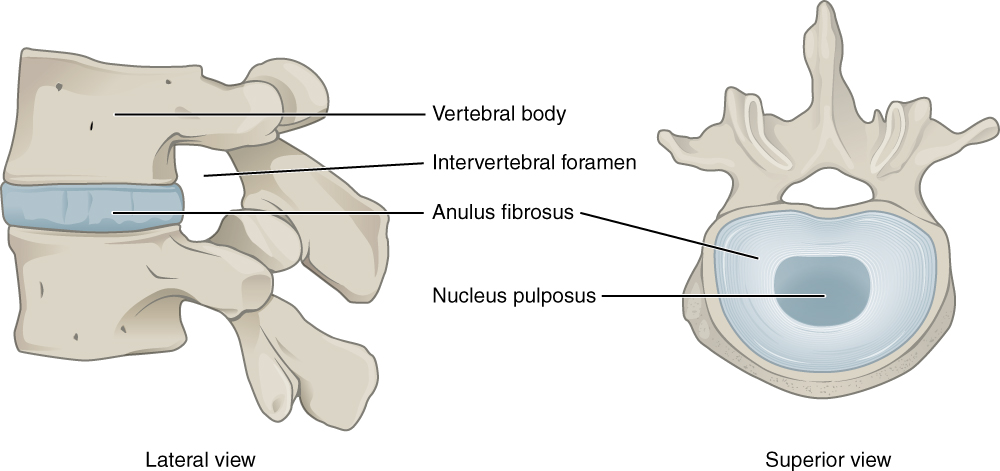Defining Degenerative Disc Disease
Intervertebral disc degeneration is a very common problem among both men and women. It can be a result of the normal aging process, and is often times asymptomatic. The intervertebral discs are an integral part of the spine all the way from the neck down to the low back. They help maintain stability and alignment of the vertebral bodies (refer to diagram below) as well as help to absorb shock exerted through the spine during daily activities. Following are some risk factors associated with the development of degenerative disc disease (DDD): aging, injury or trauma to the spine, heavy and repetitive activities, and poor nutrition. There is another factor that may actually initiate or accelerate the development of DDD, and that would be smoking cigarettes. At this point in time, most people are aware of the dangers and risk factors associated with smoking, but it may not be as widely known that smoking can contribute to low back pain associated with DDD.
The Two Ways that Smoking can Impact the Development of DDD
The issue with smoking as it relates to the development of DDD involves nicotine, which is the main ingredient in tobacco. Nicotine is a proven vasoconstrictor, which by definition of the word, decreases blood flow secondary to the blood vessels “shrinking” because of the chemical response the body produces when nicotine is introduced into the blood stream. Another way that nicotine affects the intervertebral disc is due to a reaction caused by a chemical irritation of the disc secondary to an inflammatory response that occurs. This inflammatory response causes breakdown of the material which makes up the disc itself.
The intervertebral disc is made up of an outer ring called the annulus fibrosis. This is a thick outer ring that is made up of material composed of collagen. The inner layer of the disc is called the nucleus pulposus. This is a more gel-like structure made up mostly of water and a protein-like gel. The disc itself does not have any blood supply to provide it with nutrient rich cells. They rely purely on the blood supply to the bones around the disc. The vasoconstriction that occurs from nicotine exposure affects the large network of blood vessels that surround the disc. The first part of that network does supply blood to the annulus. The other part of that network is made up of vascular buds that are present on the vertebral endplates (area of the vertebral body above and below each disc) which carry nutrients to the intervertebral discs. Please refer to diagram below.
Therefore, even though the discs themselves are not vascular structures, nicotine does cause vasoconstriction to the vessels that supply the bones adjacent to the discs with nutrients that help to keep them viable and healthy. This decrease in tissue oxygenation, which is crucial for disc metabolism, results in decreased synthesis of collagen which can lead to degeneration of the disc. A good way to think about this process is such that the effects from smoking are essentially like the disc being suffocated.
As previously mentioned, the introduction of nicotine into the blood stream elicits an inflammatory response in the body. The definition of inflammatory response is what happens when tissues or cells are injured, in this case by a toxin such as nicotine. When the body recognizes this, chemicals are secreted as a protective mechanism. It has been shown in research studies that the secretion of these chemicals does play a role in the development of disc degeneration.
How Smoking Negatively Impacts Spinal Fusion Procedures
Besides the impact it has on the development of DDD, smoking also poses another threat to the health of the spine. For patients who have had, or are considering spinal fusion procedures, it is important to examine the affect that smoking has on the success rate of these types of surgeries. It has been reported that symptomatic fusion failure is 3 to 5 times more common among smokers rather than non-smokers. It is well described that smoking delays bone healing. Successful bony fusion depends on the following factors: preparation of the fusion site, healing at the fusion site, and the body’s response to the material used for fusion. Adequate blood flow and a good healing response are key in developing a solid bony fusion in the lumbar spine. Since chronic smokers are known to have a decreased blood supply and abnormal cell metabolism in and around the spine, they are less able to mount the appropriate response to fuse the bone.
Benefits of Smoking Cessation in Relation to the Health of the Spine
The studies that have been done to assess the risk of smoking in relation to the development of DDD have shown that this risk is present in chronic, long-time smokers. The good news is that smoking cessation can have a positive impact and these problems can be either reserved or halted, not allowing them to get worse. In relation to DDD, the benefits of quitting smoking can be seen as early as 2-3 months. Once the toxin, nicotine, is out of the system, the condition of the vasculature and inflammatory response virtually returns to that of a non-smoker. Therefore, it truly is never too late to reap the benefits of quitting smoking. Please visit upmc.com and type “smoking cessation” into the search bar for available resources to aid in quitting smoking.

